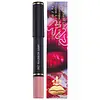What's inside
What's inside
 Key Ingredients
Key Ingredients

 Benefits
Benefits

 Concerns
Concerns

 Ingredients Side-by-side
Ingredients Side-by-side

Isododecane
EmollientPolyethylene
AbrasiveTrimethylsiloxyphenyl Dimethicone
Isohexadecane
EmollientDimethicone
EmollientAcrylates/Dimethicone Copolymer
Skin ConditioningPolypropylsilsesquioxane
Stearyl Heptanoate
EmollientHydrogenated Polyisobutene
EmollientHydrogenated Styrene/Methylstyrene/Indene Copolymer
Alumina
AbrasiveSynthetic Fluorphlogopite
Calcium Aluminum Borosilicate
Limonene
PerfumingCalcium Sodium Borosilicate
Aluminum Hydroxide
EmollientPolybutylene Terephthalate
Silica
AbrasiveMagnesium Silicate
AbsorbentSilica Silylate
EmollientEthylene/Va Copolymer
Emulsion StabilisingAcrylates Copolymer
Pentaerythrityl Tetra-Di-T-Butyl Hydroxyhydrocinnamate
AntioxidantBenzyl Benzoate
AntimicrobialTin Oxide
AbrasiveBenzyl Alcohol
PerfumingCitronellol
PerfumingLinalool
PerfumingGeraniol
PerfumingDisodium Stearoyl Glutamate
CleansingTocopherol
AntioxidantParfum
MaskingCI 77891
Cosmetic ColorantCI 77491
Cosmetic ColorantCI 77492
Cosmetic ColorantCI 77499
Cosmetic ColorantCI 45410
Cosmetic ColorantCI 15850
Cosmetic ColorantCI 45380
Cosmetic ColorantMica
Cosmetic ColorantCI 15985
Cosmetic ColorantCI 19140
Cosmetic ColorantCI 77163
Cosmetic ColorantCI 17200
Cosmetic ColorantCI 42090
Cosmetic ColorantCI 75470
Cosmetic ColorantIsododecane, Polyethylene, Trimethylsiloxyphenyl Dimethicone, Isohexadecane, Dimethicone, Acrylates/Dimethicone Copolymer, Polypropylsilsesquioxane, Stearyl Heptanoate, Hydrogenated Polyisobutene, Hydrogenated Styrene/Methylstyrene/Indene Copolymer, Alumina, Synthetic Fluorphlogopite, Calcium Aluminum Borosilicate, Limonene, Calcium Sodium Borosilicate, Aluminum Hydroxide, Polybutylene Terephthalate, Silica, Magnesium Silicate, Silica Silylate, Ethylene/Va Copolymer, Acrylates Copolymer, Pentaerythrityl Tetra-Di-T-Butyl Hydroxyhydrocinnamate, Benzyl Benzoate, Tin Oxide, Benzyl Alcohol, Citronellol, Linalool, Geraniol, Disodium Stearoyl Glutamate, Tocopherol, Parfum, CI 77891, CI 77491, CI 77492, CI 77499, CI 45410, CI 15850, CI 45380, Mica, CI 15985, CI 19140, CI 77163, CI 17200, CI 42090, CI 75470
Dimethicone
EmollientTrimethylsiloxysilicate
EmollientCaprylyl Methicone
Skin ConditioningOctyldodecanol
EmollientSynthetic Wax
AbrasiveLauroyl Lysine
Skin ConditioningDiisostearyl Malate
EmollientPhenylpropyldimethylsiloxysilicate
EmollientDisteardimonium Hectorite
StabilisingPolyethylene
AbrasiveCopernicia Cerifera Wax
Stearyl Heptanoate
EmollientStearyl Caprylate
EmollientPropylene Carbonate
SolventCaprylic/Capric Triglyceride
MaskingPolyhydroxystearic Acid
EmulsifyingPentaerythrityl Tetra-Di-T-Butyl Hydroxyhydrocinnamate
AntioxidantIsostearic Acid
CleansingLecithin
EmollientPolyglyceryl-3 Polyricinoleate
EmulsifyingDicalcium Phosphate
AbrasiveCI 77891
Cosmetic ColorantIron Oxides
CI 15850
Cosmetic ColorantCI 42090
Cosmetic ColorantDimethicone, Trimethylsiloxysilicate, Caprylyl Methicone, Octyldodecanol, Synthetic Wax, Lauroyl Lysine, Diisostearyl Malate, Phenylpropyldimethylsiloxysilicate, Disteardimonium Hectorite, Polyethylene, Copernicia Cerifera Wax, Stearyl Heptanoate, Stearyl Caprylate, Propylene Carbonate, Caprylic/Capric Triglyceride, Polyhydroxystearic Acid, Pentaerythrityl Tetra-Di-T-Butyl Hydroxyhydrocinnamate, Isostearic Acid, Lecithin, Polyglyceryl-3 Polyricinoleate, Dicalcium Phosphate, CI 77891, Iron Oxides, CI 15850, CI 42090
Ingredients Explained
These ingredients are found in both products.
Ingredients higher up in an ingredient list are typically present in a larger amount.
Ci 15850 is the pigment color red. It is an azo dye and created synthetically.
Azo dyes need to be thoroughly purified before use. This allows them to be more stable and longer-lasting.
This ingredient is common in foundations, lipsticks, and blushes. This color is described as brown/orangey red.
It has many secondary names such as Red 6 and Red 7. According to a manufacturer, Red 6 usually contains aluminum.
Learn more about CI 15850Ci 42090 is a synthetic dye created from petroleum. It is used to give a bright blue color to cosmetics, medicine, and food.
Ci 77891 is a white pigment from Titanium dioxide. It is naturally found in minerals such as rutile and ilmenite.
It's main function is to add a white color to cosmetics. It can also be mixed with other colors to create different shades.
Ci 77891 is commonly found in sunscreens due to its ability to block UV rays.
Learn more about CI 77891Dimethicone is a type of synthetic silicone created from natural materials such as quartz.
What it does:
Dimethicone comes in different viscosities:
Depending on the viscosity, dimethicone has different properties.
Ingredients lists don't always show which type is used, so we recommend reaching out to the brand if you have questions about the viscosity.
This ingredient is unlikely to cause irritation because it does not get absorbed into skin. However, people with silicone allergies should be careful about using this ingredient.
Note: Dimethicone may contribute to pilling. This is because it is not oil or water soluble, so pilling may occur when layered with products. When mixed with heavy oils in a formula, the outcome is also quite greasy.
Learn more about DimethiconePentaerythrityl Tetra-Di-T-Butyl Hydroxyhydrocinnamate (long name, huh?) is a synthetic antioxidant.
It is used to help stabilize other antioxidants or prevent the color from changing in a product.
As an antioxidant, it helps fight free-radical molecules. Free-radical molecules are capable of damaging our cells and other genetic material. Thus, antioxidants may reduce the signs of aging.
This ingredient is oil-soluble.
Learn more about Pentaerythrityl Tetra-Di-T-Butyl HydroxyhydrocinnamatePolyethylene is a synthetic ingredient that helps the skin retain moisture. It is a polymer.
It is also typically used within product formulations to help bind solid ingredients together and thicken oil-based ingredients. When added to balms and emulsions, it helps increase the melting point temperature.
Stearyl Heptanoate is a waxy compound derived from stearyl alcohol.
As an emollient, it helps hydrate the skin by trapping moisture. In its raw form, this ingredient is a waxy solid.
In a study with participants who had acne-prone skin, using 1.5% stearyl heptanoate was not found to be comedogenic.
However, it may cause acne in higher concentrations.
Learn more about Stearyl Heptanoate